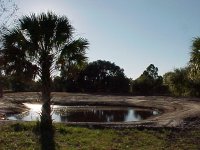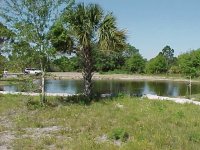JimMorrissey
Veteran Member
I'm thinking about digging a shallow (10') well to feed our old pond that was abandoned years ago, due to lack of interest by the old owners. It has a deeded water supply from a spring way up on the hill that was dammed up. I have no idea where that location once was or is. The hill behind us (old pasture) has since been developed, and without a lengthy legal battle I don't see exercising my deeded rights to have a pipe to the pond. That would mean running my pipe right through peoples yards /forums/images/graemlins/blush.gif
Anyway, my thought is that I could dig a pit and sink some kind of concrete or plastic colvert into the hole....so the colvert would be standing on its end. Prior to dropping it in, I'd punch a bunch of holes in it to let the water flow into the tube. I'm thinking about a standard colvert approx. 3' or 4' in diameter and nine feet long, which would hold about 350 gallons at a time when full. Some type of pump would be put into the hole to move the water to the pond. The well and pump would be about 350' from the pond and the elevation change is about 10-12'.
The land is very wet at the lower part of the property (natural spring?) and a far side neighbor has started to divert a substantial amount of runoff onto a lower area of my property not too far away. I'd like to take advantage of my neighbor's poor dainage planning and let gravity flow the water from the neighbors to the well as an additional supply. I would have to pipe it from about 175' from the side neighbor to the proposed shallow well.
The pond in question is pretty large ( 150' x 140' x 15' x 7.48) about 150,000 gallons. Is it crazy to think that I could keep a pond of this size fed with an electric pump? The colvert/well with 350 gallons full would need to be pumped out nearly 500 times to fill the pond. The core issues seem to be how fast the colvert can refill itself and how good the pond is at holding water. I guess the question then comes down to electricity, and would this be a crazy way to fill a pond and maintain its level.
How much electricity would it take to pump 160,000 gallons....350 feet @ 12' of elevation change? What kind of pump should I be looking at? Is solar a possible soluton to power the pump?
Lots of questions....sorry about the ramble.
Anyway, my thought is that I could dig a pit and sink some kind of concrete or plastic colvert into the hole....so the colvert would be standing on its end. Prior to dropping it in, I'd punch a bunch of holes in it to let the water flow into the tube. I'm thinking about a standard colvert approx. 3' or 4' in diameter and nine feet long, which would hold about 350 gallons at a time when full. Some type of pump would be put into the hole to move the water to the pond. The well and pump would be about 350' from the pond and the elevation change is about 10-12'.
The land is very wet at the lower part of the property (natural spring?) and a far side neighbor has started to divert a substantial amount of runoff onto a lower area of my property not too far away. I'd like to take advantage of my neighbor's poor dainage planning and let gravity flow the water from the neighbors to the well as an additional supply. I would have to pipe it from about 175' from the side neighbor to the proposed shallow well.
The pond in question is pretty large ( 150' x 140' x 15' x 7.48) about 150,000 gallons. Is it crazy to think that I could keep a pond of this size fed with an electric pump? The colvert/well with 350 gallons full would need to be pumped out nearly 500 times to fill the pond. The core issues seem to be how fast the colvert can refill itself and how good the pond is at holding water. I guess the question then comes down to electricity, and would this be a crazy way to fill a pond and maintain its level.
How much electricity would it take to pump 160,000 gallons....350 feet @ 12' of elevation change? What kind of pump should I be looking at? Is solar a possible soluton to power the pump?
Lots of questions....sorry about the ramble.


